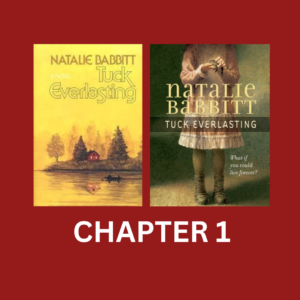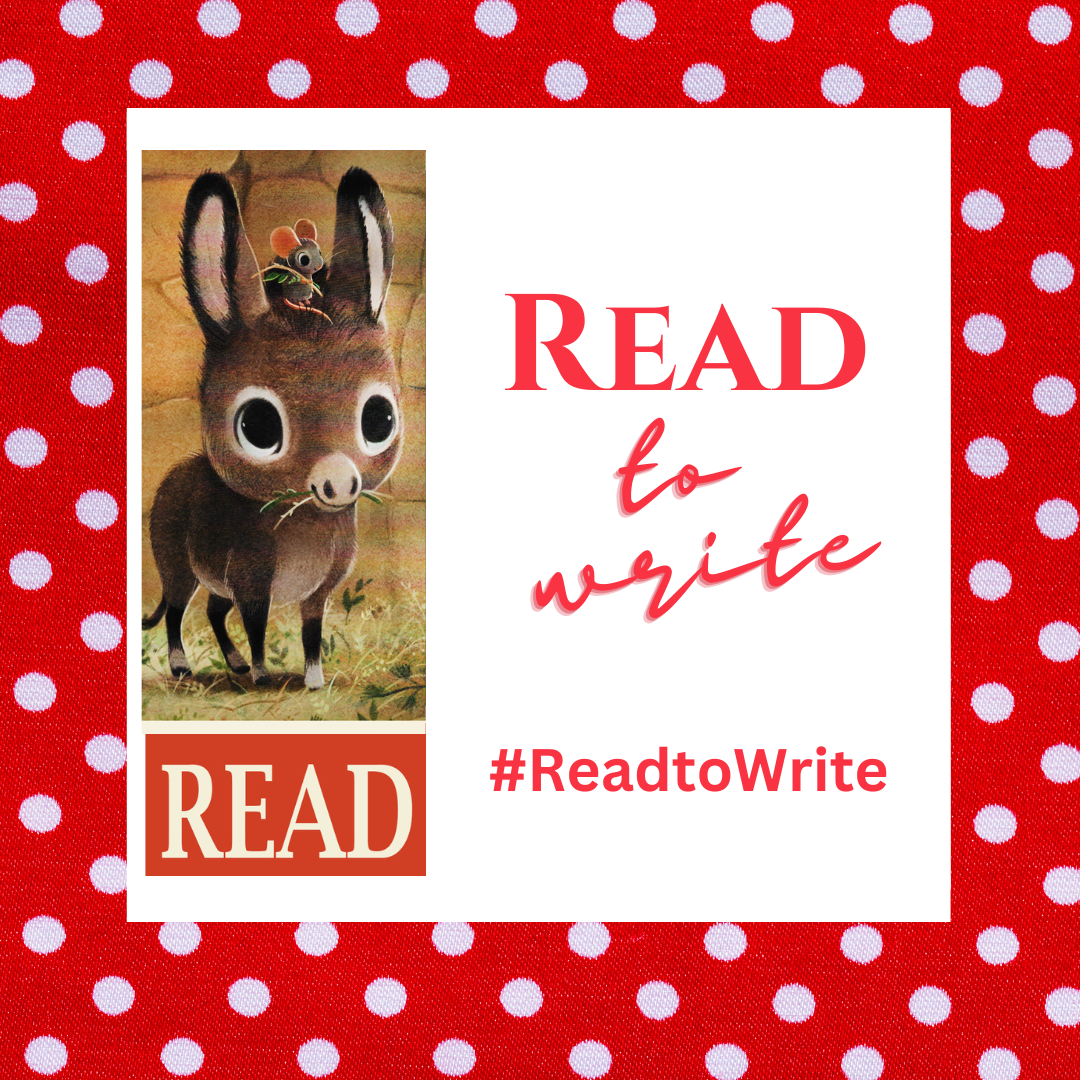
Chapter 1 of Tuck Everlasting contrasts the eternal, perfect freedom of nature, as opposed to the rigid, confined existence outside of nature–specifically to that in the Foster’s Home in Treegap, the town at the edge of the Wood or Nature.
“The road that led to Treegap had been trod out long before by a herd of cows who were, to say the least, relaxed. It wandered along in curves and easy angles, swayed off and up in a pleasant tangent to the top of a small hill, ambled down again between fringes of bee-hung clover, and then cut sidewise across a meadow. Here its edges blurred. It widened and seemed to pause, suggesting tranquil bovine picnics: slow chewing and thoughtful contemplation of the infinite. And then it went on again and came at last to the wood.
“But on reaching the shadows of the first trees, it veered sharply, swung out in a wide arc as if, for the first time, it had reason to think where it was going, and passed around.
“On the other side of the wood, the sense of easiness dissolved. The road no longer belonged to the cows. It became, instead, and rather abruptly, the property of people. And all at once the sun was uncomfortably hot, the dust oppressive, and the meager grass along its edges somewhat ragged and forlorn.

“On the left stood the first house, a square and solid cottage with a touch-me-not appearance, surrounded by grass cut painfully to the quick and enclosed by a capable iron fence some four feet high which clearly said, “Move on—we don’t want you here.” So the road went humbly by and made its way, past cottages more and more frequent but less and less forbidding, into the village. But the village doesn’t matter, except for the jailhouse and the first house, the road, and the wood.” Babbitt, Tuck, pgs. 5-6.
Athough some of the movie Tuck Everlasting was filmed in the Ozark Mountains, near my former home, the Foster”s house and its daunting fence was filmed in a town in Maryland. The Ozark Mountains is a natural paradise. Contrast that to the untouchable house imprisoned by a Gothic fence.
The mood of the house and fence above remind me of that in Carl Sandburg’s poem: “A Fence.”
“There was something strange about the wood. If the look of the first house suggested that you’d better pass it by, so did the look of the wood, but for quite a different reason**. The house was so proud of itself that you wanted to make a lot of noise as you passed, and maybe even throw a rock or two.* Babbitt, Tuck, pg,. 6.
Contrast the setting and tone of the Foster’s house in town to that of the Wood:
“But the wood had a sleeping, otherworld appearance that made you want to speak in whispers. This, at least, is what the cows must have thought: “Let it keep its peace; we won’t disturb it.” Whether the people felt that way about the wood or not is difficult to say. There were some, perhaps, who did. But for the most part the people followed the road around the wood because that was the way it led. There was no road through the wood.” Babbitt, pgs. 6-7.
In saying that there was no road through the wood, I believe that Babbitt is echoing the Taoist thought about “The Way.” In very simplistic terms, “The Way” is beyond maps and doctrines and teachings and names. “The Way” is the eternal thread that runs much deeper than the other–it is the infinite. When men try to name or map or explain “The Way,” it vanishes,
Tao Te Ching
Chapter 25People follow earth,
earth follows heaven,
heaven follows the Way,
Interpreted by Ursula Le Guin
Lao Tzu: Tao Te Ching: Book about The Way and The Power of The Way
The Opening of the Movie Tuck Everlasting Was Filmed at Hawksbill Crag in the Ozark Mountains
Until a Year Ago, I Lived in the Ozark Mountains. During that time, I Created the Following:
“There was another reason to leave the wood to itself: it belonged to the Fosters, the owners of the touch-me-not cottage, and was therefore private property in spite of the fact that it lay outside the fence and was perfectly accessible.
“The ownership of land is an odd thing when you come to think of it. How deep, after all, can it go? If a person owns a piece of land, does he own it all the way down, in ever narrowing dimensions, till it meets all other pieces at the center of the earth? Or does ownership consist only of a thin crust under which the friendly worms have never heard of trespassing?” Babbitt, Tuck, pg. 7.
In talking about the ownership of land, Babbitt is talking about the fact nature is beyond ownership — it is an eternal. The song in the Disney Movie Pocahontas talks about that same eternal quality:
Lyrics:
“You think you own whatever land you land onThe Earth is just a dead thing you can claimBut I know every rock and tree and creatureHas a life, has a spirit, has a name …
“In any case, the wood, being on top—except, of course, for its roots—was owned bud and bough by the Fosters in the touch-me-not cottage, and if they never went there, if they never wandered in among the trees, well, that was their affair. Winnie, the only child of the house, never went there, though she sometimes stood inside the fence, carelessly banging a stick against the iron bars, and looked at it. But she had never been curious about it. Nothing ever seems interesting when it belongs to you—only when it doesn’t.
“And what is interesting, anyway, about a slim few acres of trees? There will be a dimness shot through with bars of sunlight, a great many squirrels and birds, a deep, damp mattress of leaves on the ground, and all the other things just as familiar if not so pleasant—things like spiders, thorns, and grubs.
“In the end, however, it was the cows who were responsible for the wood’s isolation, and the cows, through some wisdom they were not wise enough to know that they possessed, were very wise.” Babbitt, Tuck, pg. 7-8.

Several times, I have said that one of my reasons to study Tuck Everasting is that it offers a Handbook of Writing Tips for Writers and/or Prospective Writers.
In Chapter 1, Babbitt Illustrates Descriptive Writing
Description of the Road toward Treegap
“The road that led to Treegap had been trod out long before by a herd of cows who were, to say the least, relaxed. It wandered along in curves and easy angles, swayed off and up in a pleasant tangent to the top of a small hill, ambled down again between fringes of bee-hung clover, and then cut sidewise across a meadow. Here its edges blurred. It widened and seemed to pause, suggesting tranquil bovine picnics: slow chewing and thoughtful contemplation of the infinite. And then it went on again and came at last to the wood. Babbitt, Tuck Everlasting, pg. 5.
Desciption of the Area Nearer Treegap
“On the other side of the wood, the sense of easiness dissolved. The road no longer belonged to the cows. It became, instead, and rather abruptly, the property of people. And all at once the sun was uncomfortably hot, the dust oppressive, and the meager grass along its edges somewhat ragged and forlorn.” Babbitt, Tuck Everlasting, pgs. 5-6.
Description of the Foster House and Its Fence
“On the left stood the first house, a square and solid cottage with a touch-me-not appearance, surrounded by grass cut painfully to the quick and enclosed by a capable iron fence some four feet high which clearly said, “Move on—we don’t want you here.” Babbitt, Tuck Everlasting, pg. 6.
Description of the Wood
“But the wood had a sleeping, otherworld appearance that made you want to speak in whispers. This, at least, is what the cows must have thought: “Let it keep its peace; we won’t disturb it….. There will be a dimness shot through with bars of sunlight, a great many squirrels and birds, a deep, damp mattress of leaves on the ground, and all the other things just as familiar if not so pleasant—things like spiders, thorns, and grubs. Babbitt, Tuck Everlasting, pgs. 7-8.
My Garden is Where I Maintain a Natural Space that I “….Want to Speak in Whispers.” But I Initially Discovered My Spiritual Connection to Nature as a Child at Camp.
One reason that I love Tuck Everlasting is that it is a book written for and about children. At its core, it assumes that some children have a capacity to understand that nature can be a link to the sacred. Not all children have the capacity to grasp the metaphysical, but not all adults have that capacity, too.
When I was a child, I got it, but I felt that I was different because I got it, and I realized that I was alone in that I related to whispers that others around me never seemed to hear. Again, I am happy that there are books that speak to those children who might seem that they are alone in the ways that they perceive the world. When I was a child, I recognized the spiritual in nature at campl
On Sunay mornings at camp, the campers would amass at the top of a mountain, and as we walked down into the heart of the forest, we would sing, “We Are Climbing Jacob’s Ladder.” There was no talking or giggling. The group was silent until we landed at a woodland chapel nestled deep in The Wood. As Babbitt described it, streaks of light filtered through the trees here and there, and bits of sky peeked through the branches and leaves overhead. To this day, I call that streaking light “God’s Light,” and about a year ago, I captured God’s Light shining in my garden:

Sundial in Jacki Kellum Garden
But at camp, I perceived the sacred in other places, too–especially at campfires down at the lakeside, and as we sang songs like “Peace, I Ask of Thee Oh River.”
I have sensed the presence of God in the rivers, the hills, and in my garden almost all my life, and I especially love books that seek to describe that spiritual essence of nature.
WHAT IS THE PURPOSE OF DESCRIPTION IN WRITING?
-
Creating vivid imagery:Descriptions help readers visualize the characters, places, and situations in the story, allowing them to become more immersed in the world the author has created.
-
Sensory experience:Effective description uses sensory details to recreate experiences for the reader, making the story more engaging and interesting to read.
-
Revealing character traits:Descriptions of a character’s physical appearance, mannerisms, and surroundings can reveal their personality, background, and motivations.
-
Emotional connection:Descriptions can evoke emotions in the reader, helping them to connect with the characters and their experiences.
-
Establishing the mood:Descriptions can create a specific mood or atmosphere, such as suspense, tranquility, or danger.
-
Moving the plot forward:Descriptions can be used to foreshadow events, create tension, and build suspense.
-
Adding life and depth:Good descriptions can breathe life into the story, making the characters and setting feel more real and believable.
-
Improving comprehension:Descriptions can help readers to better understand the text and the author’s intentions.
-
Balance:While descriptions are important, they should not be overused or become too longwinded, as this can slow down the pace of the story.
-
Show, don’t tell:Effective descriptions show the reader what is happening, rather than simply telling them.
-
Sensory details:Using sensory details such as sight, sound, smell, touch, and taste can make descriptions more vivid and engaging.
-
Figurative language:Similes, metaphors, and other figures of speech can be used to create more imaginative and evocative descriptions.
Good Descriptve Writing Is What Distinguishes the Words in a Dictionary from the Words in Somethiing More Effective and Eternal
To Learn More about Writing Good Description, Read Word Painting by Rebecca McClanahan:
Word Painting – How to Write Descriptively by Rebecca McClanahan
Discover more from Jacki Kellum
Subscribe to get the latest posts sent to your email.